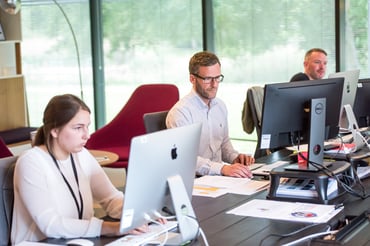Did you know that not that long ago, drones were one of the bestselling Christmas presents?
Drones have been an exceptional innovation with a huge range of uses from land surveying to parcel delivery and even checking power lines without the dangers involved in someone hanging from a helicopter.
But it’s not that straightforward in the drone world when it comes to business applications. For example, because of regulations like America’s Federal Aviation Authority’s near ban on commercial drones, this former military innovation’s route to market might remain partially blocked and its potential might remain severely underexploited.
That’s why one of the fundamental requirements for open innovation is clarifying the operating principles. Finding the middle ground with regulators and establishing formal consensus about what can and should be done to benefit everyone in a product’s ecosystem (policymakers, users, service providers, etc.) is essential to get the most from open innovation.
Resolving conflict is another fundamental requirement for successful open innovation. In the drone example, the conflict between those requiring drone operators to have experience flying manned aircraft and those advocating a distinct type of certification (or no certification at all) is a case in point.
The bottom line? Unless cases like these are consistently resolved, the full benefits of drone technology, and much more, might remain elusive to the 7 billion non-astronauts like you and me.
What, then, are the essential good practices that enable open innovation to flourish? As in the drone example above, the key prerequisites are clarifying operating principles and resolving conflict.
I came across a great paper, “Good Practices in Open Innovation”, by Gene Slowinski and Matthew W. Sagal, which sets out 12 best practices the authors associate with high-quality open innovation. Gene Slowinski is the director of strategic alliance research at Rutgers University Business School and a managing partner at Alliance Management Group, Inc. and Matthew W. Sagal is one of Alliance Management’s Group’s senior partners. Previously, Sagal was an R&D, manufacturing, and business development executive at Bell Laboratories and AT&T.
Here, we share Slowinski and Sagal’s fascinating insights, including the 12 best practices they associate with high-quality open innovation systems and processes.
Hopefully, their insights will inspire you in your innovation journey.
1. Incorporate external thinking into your strategic planning process
Use the external world as a source of inspiration and talent for your next strategic planning endeavor. Ask yourself questions like:
- What are the unmet customer needs that could lead to a more valuable product, service, or business model?
- What internal resources do you, as a firm have, to meet these needs?
- What external resources and assets could your firm source to meet these needs?
- Do you have the capacity (and willingness) to nurture collaborative relationships to acquire these external assets and resources?
2. Convert your planning outcomes into a set of prioritized briefs
Convert your inspiration and planning outcomes into a brief or a concrete list of wanted assets and start planning. Your planning will comprise issues like:
- How does a specific asset fit into your new product or service?
- What benefits can it deliver to the customer?
- Are there any intellectual property issues affecting the asset or its acquisition?
- Are there any minimum requirements and appropriate metrics to determine whether an asset meets your needs?
It’s vital to keep in mind that your list is an ever-iterating document, which will constantly change as new information and insights are added.
3. Have a clear build-vs-buy decision-making process
It goes without saying that some assets will be more efficiently developed in-house, whereas there may be a better alternative for other procurements. Your firm must have a rigorous and dependable system that can make this distinction. How else will it engineer its next triumph?
4. Look inside first
Employees and your own corporate databases are excellent sources when it comes to finding the missing piece of the resource puzzle. Mining internal tacit knowledge is also a useful technique, alongside patent mapping and literature searches.
Equally important is the communication tool you’re using – how will you ask for inputs from your internal community? Is an innovation campaign the best way forward? You might wish to consider using something like HYPE Innovation’s idea management software.
5. Treat the asset acquisition effort as a mutually beneficial process
The small-world problem between any two individuals in the Internet age generates fierce competition for the best assets and the sources that produce them. Moreover, it means that you, as a firm, need to come through as an attractive ally rather than just a demanding seeker.
Look at the lengths to which Salesforce is going to be an (open) innovation partner of choice; the CRM (client relationship management) software provider even rewards consulting partners (from the Salesforce ecosystem) that help to drive customer companies’ transformations.
6. Use information gathered along the way to refine the original brief
As you interact with internal and external sources, feedback should be continuously added to the brief, and the new document should eventually go to the stakeholders for comments and approval. As Slowinski and Sagal note, the brief is an accurate description of a firm’s objectives – it is, therefore, crucial to invest in a systematic process for updating and “refreshing”. In other words, don’t just paste things in there.
7. Establish and maintain internal alignment
Every alliance is, in reality, three alliances in one:
- An alliance between R&D, Marketing, and Manufacturing in Company 1
- An alliance between R&D, Marketing, and Manufacturing in Company 2
- An alliance between Company 1 and Company 2, respectively, or the partnership alliance per se
A lack of alignment inside one or both partners is often the cause of failure to obtain the desired asset.
8. Use a structured process for internal planning and negotiations
Building a brief and generating a list is one thing; drafting an alliance (or partnership) contract is another. Conflicts can and will emerge at this stage and it’s best to settle them in a systematic way. Clearly written documents will avoid uncertainty and minimize the wasted resources associated with cumbersome (and fruitless) negotiations.
9. Negotiate with a focus on “Win-Win-Lose-Lose-Lose”
Executing an alliance agreement isn’t the end of the open innovation relationship. In fact, it’s just the beginning. And for the relationship to last throughout implementation, all the parties involved must view the initial deal as fair.
Compromise is once again the keyword as all parties try to maximize the benefits of being part of an agreement. This is how Coca-Cola approaches potential agreements in its new Coca-Cola Founders platform, which essentially invites collaborative (business model) innovation.
10. Hold a kick-off session to enable integration of management systems
Once the contract is in place, at the beginning of implementation process, ensure you bring together the collaborating parties’ management teams. A bad start can severely damage the relationship later on, especially if the partners vary in size. It’s not uncommon for smaller-sized enterprises to have trouble collaborating with large organizations. So it’s important to meet to identify pain points and resolve them at the outset.
This is the key point I made at the start of the blog about clarifying operating principles.
11. Use the kick-off session to ensure that each firm has the same understanding of the operating principle established in the agreement
So here’s the catch: Even if the legal departments and senior management have done their jobs in drafting a beautiful document, it’s rare that this document translates into clear instructions for the departments (from both firms) that need to work collaboratively for an extended period of time. Differing perceptions of the jobs to be done can lead to confusion. Use the kick-off sessions to speak about deeply practical matters and make sure everyone is on board.
12. Train managers in both firms in the principles of conflict resolution
This last point touches again on conflict management and resolution. Some types of conflict are productive, while others are not. The key lies in effective and timely communication in order to avoid decision-making paralysis.
So, there you have it – the 12 best practices of open innovation from Gene Slowinski and Matthew Sagal. Like any other approach or method, their advice must be viewed with caution. Gather your teams around the table, share insights, and see if there is anything you can adapt, adopt, or store for later use.
HYPE Innovation consultancy team is always ready to help you put in place the key building blocks for a sustainable innovation program.
We work with clients around the globe to define strategies and align them to the wider needs of their organization because each case is unique. Don’t hesitate to reach out!










